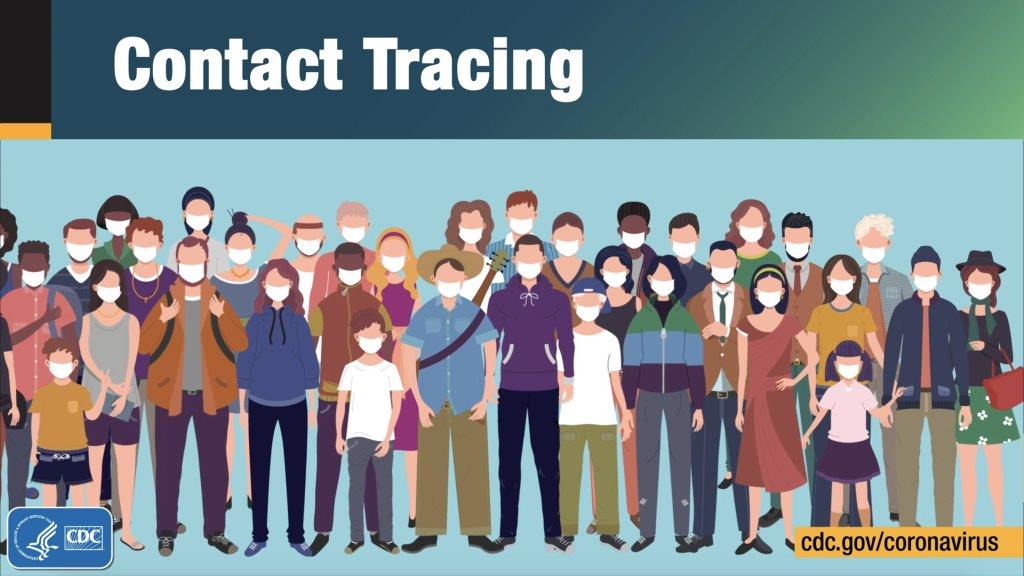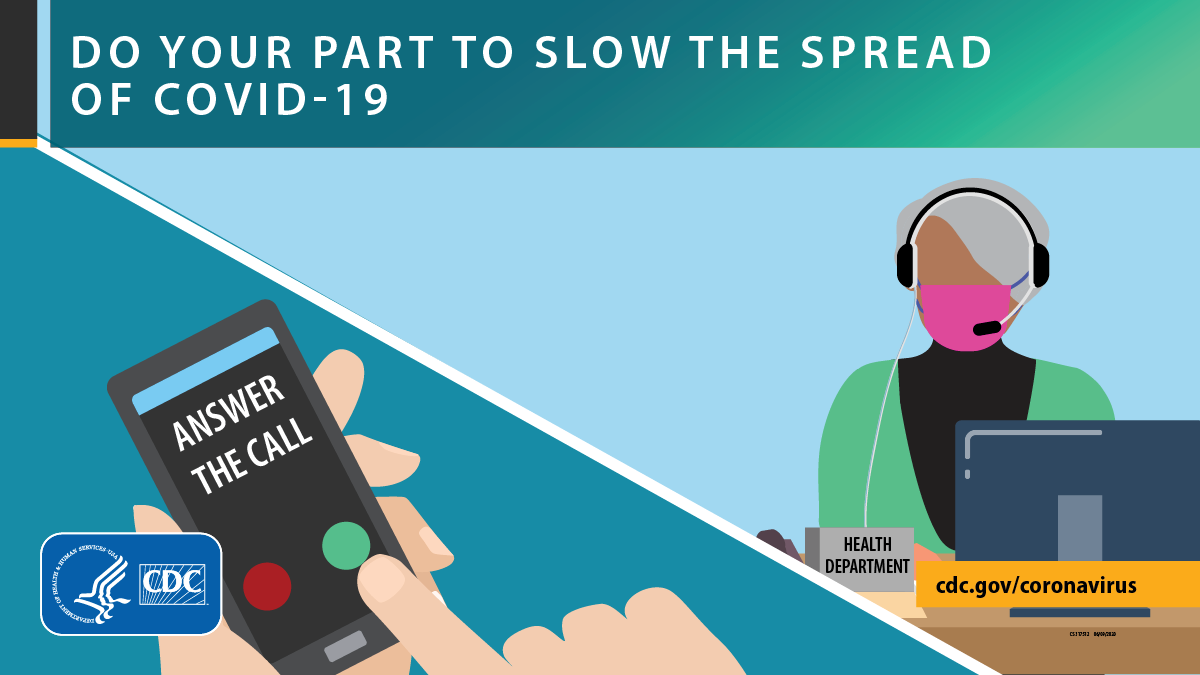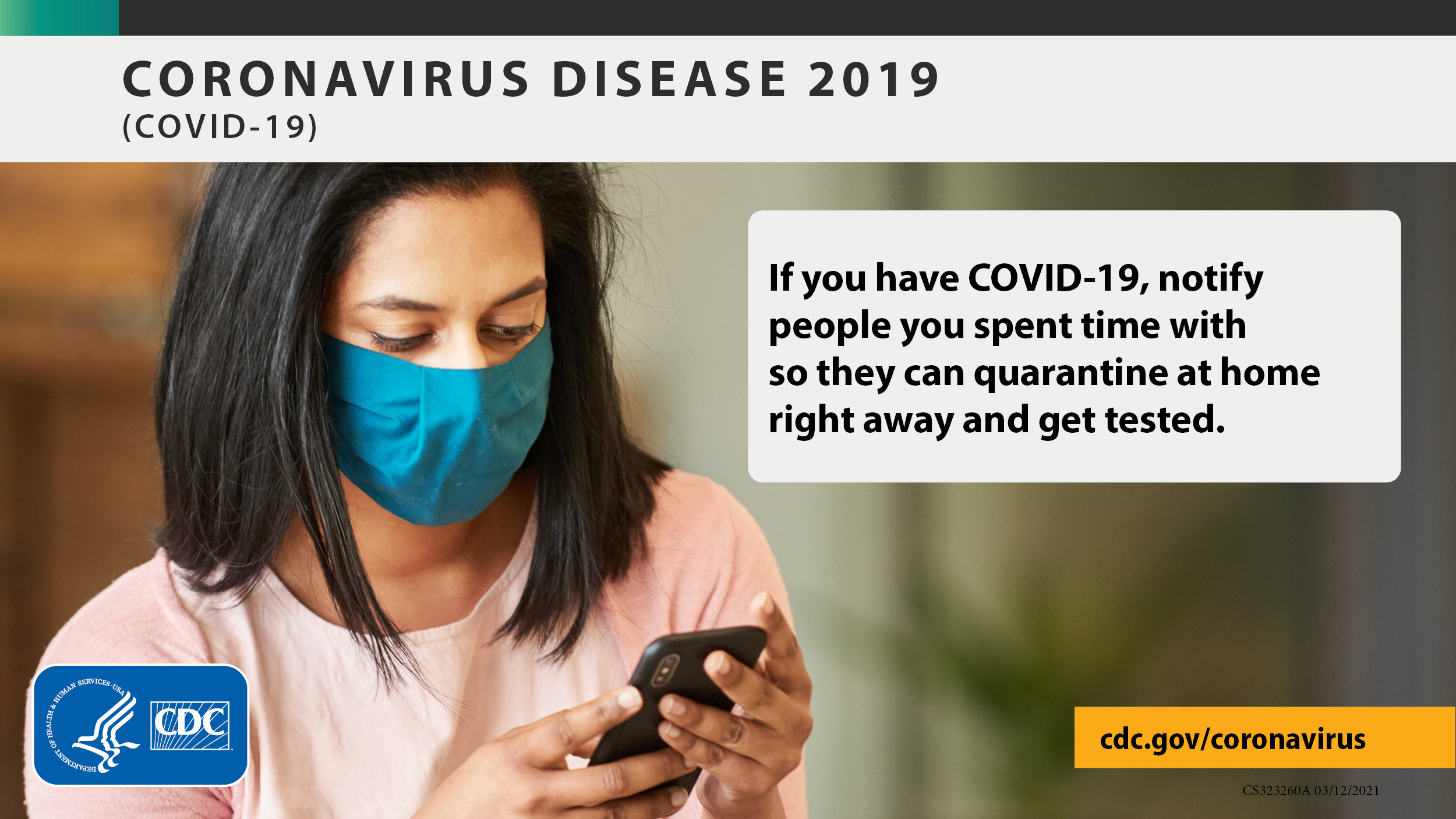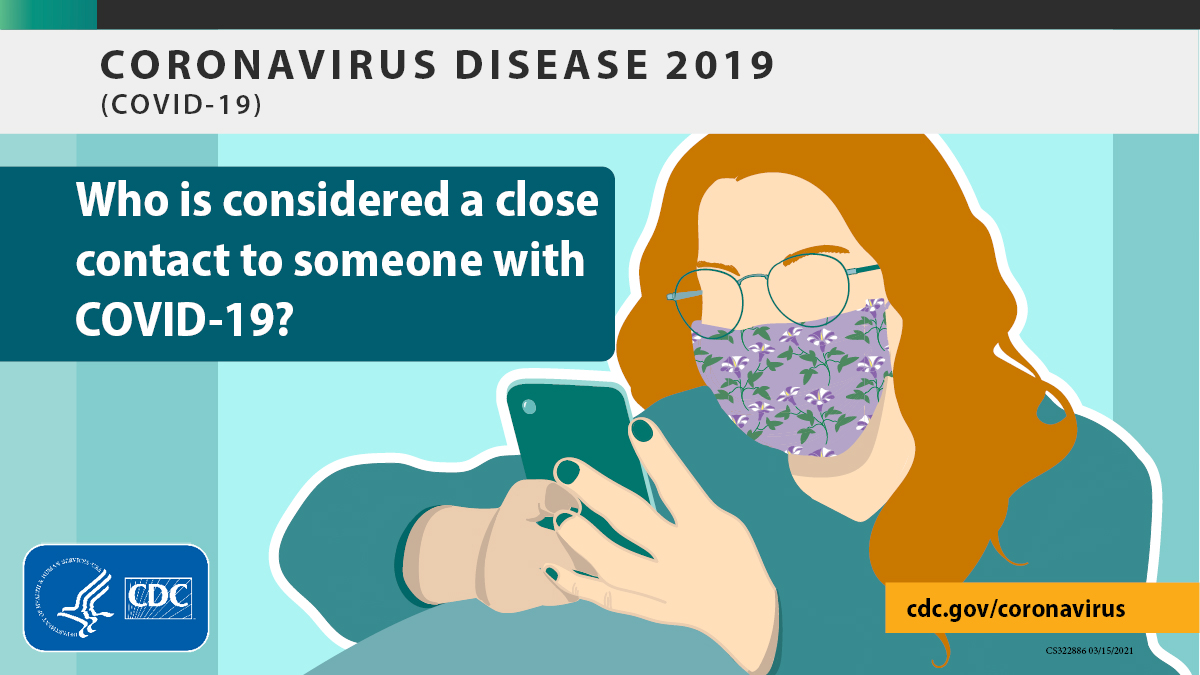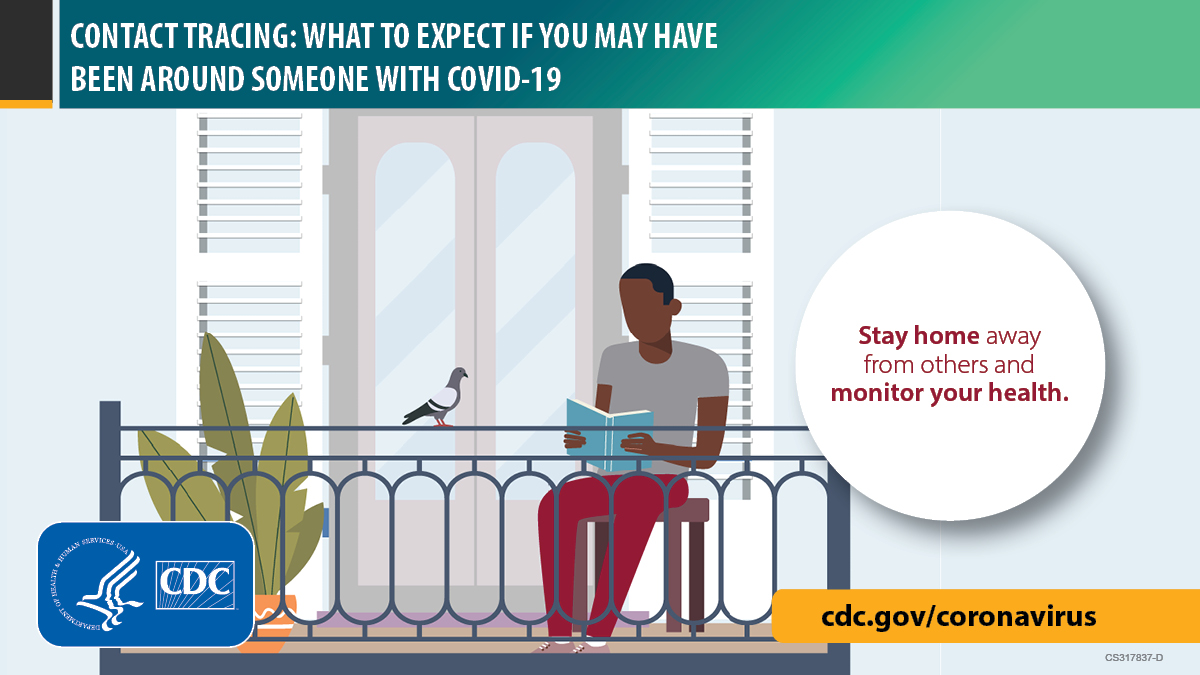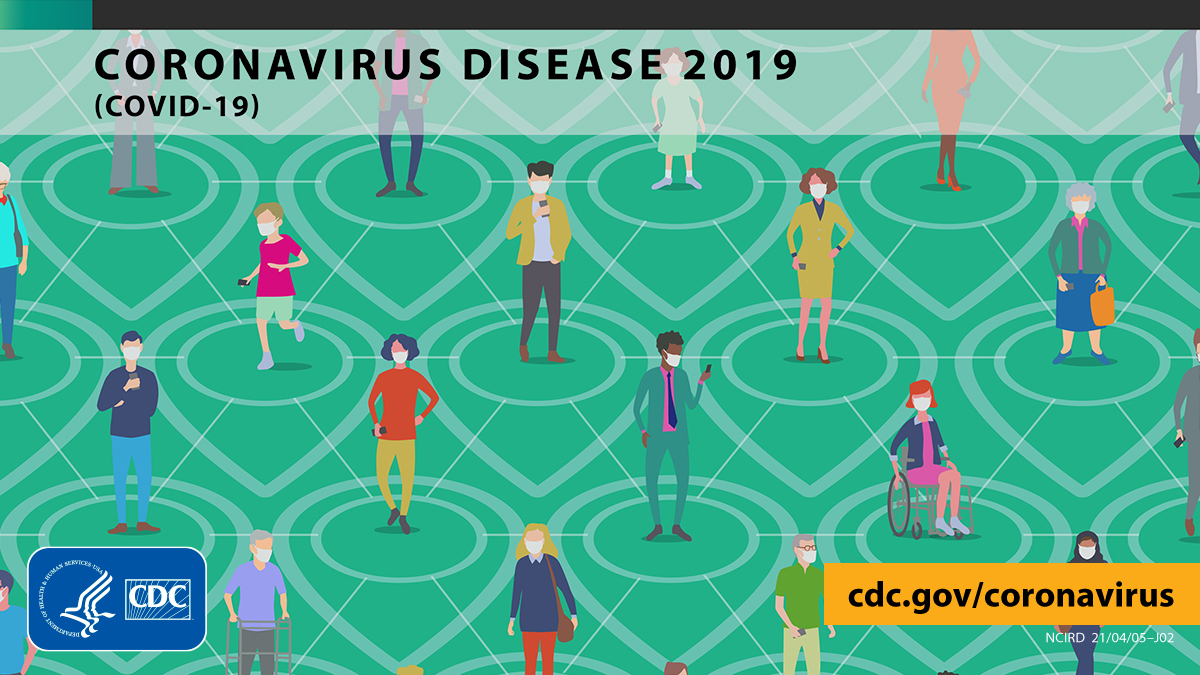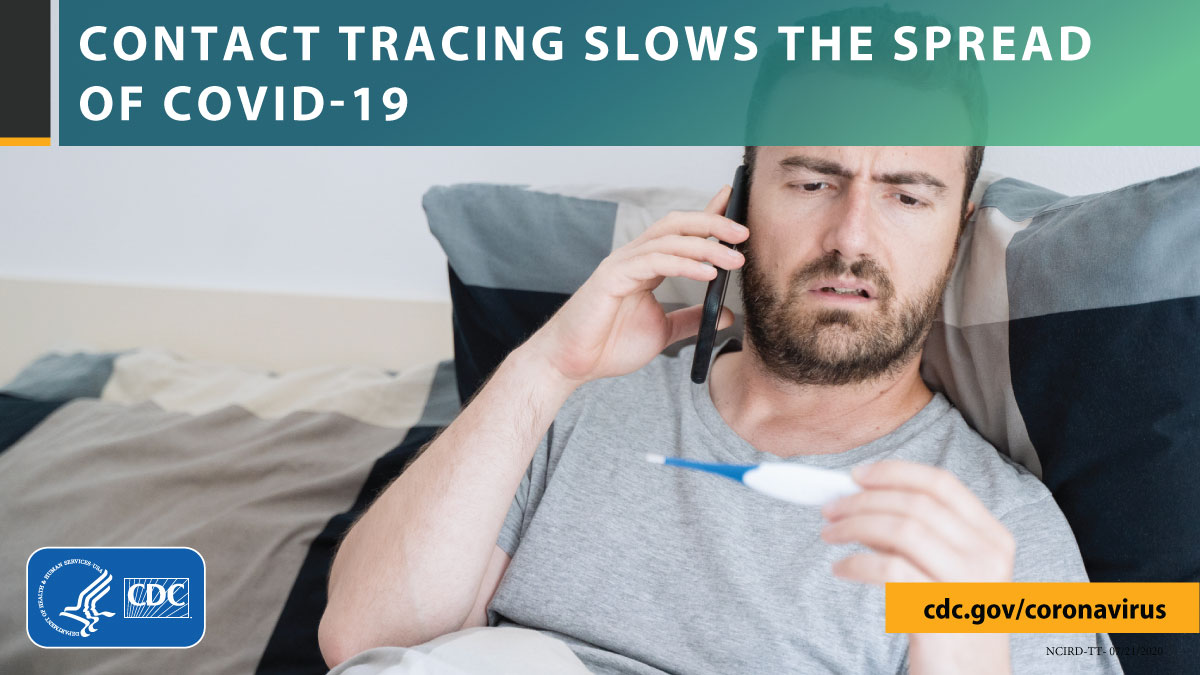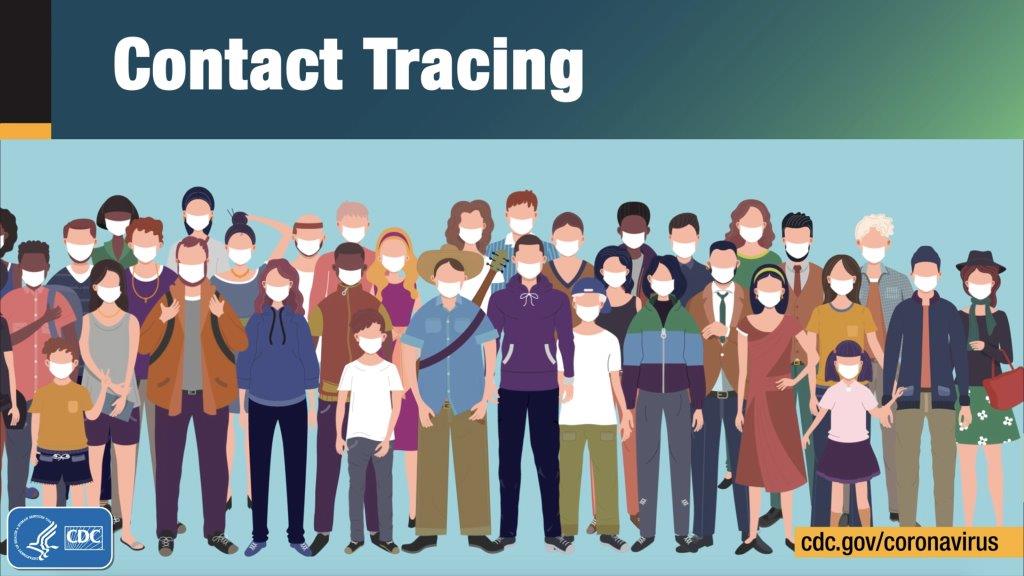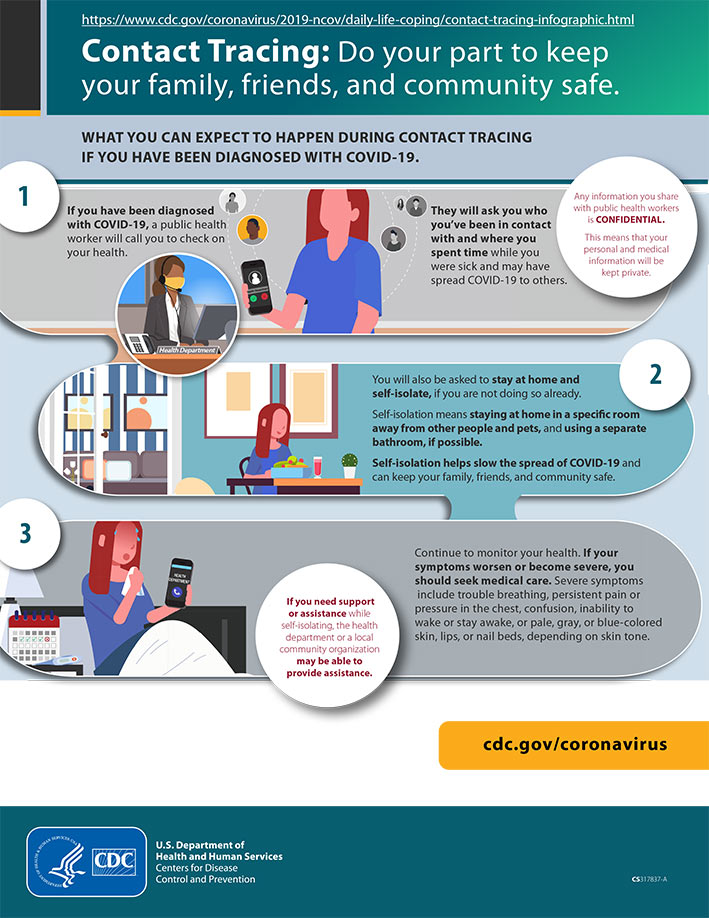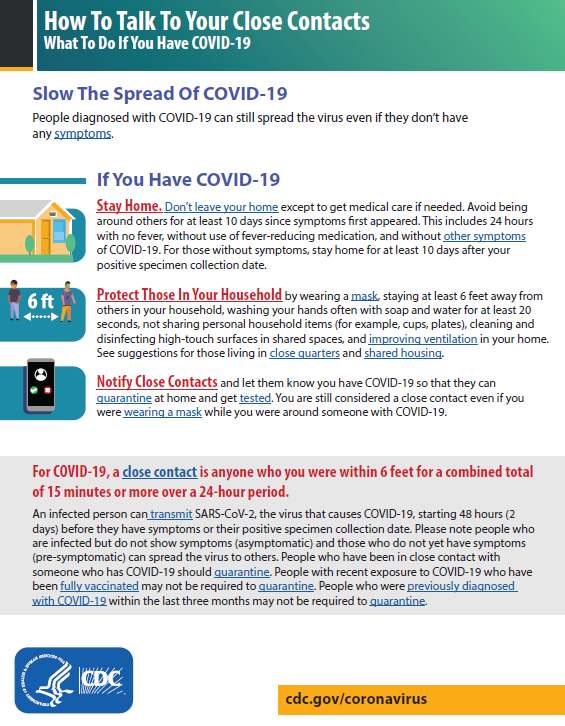Aquatics FAQs
Recommendations for Fully Vaccinated People
COVID-19 Homepage
COVID-19 Contact Tracing Communication Toolkit for Health Departments
State and local health department staff can use or adapt these ready-made materials to educate their community about case investigation and contact tracing for COVID-19. This toolkit contains key messages, sample talking points, public service announcements, social media posts, graphics, questions and answers, and links to additional resources.
For additional details on case investigation and contact tracing to inform your communication strategy, read the Interim Guidance on Developing a COVID-19 Case Investigation & Contact Tracing Plan: Overview.
This toolkit will be updated regularly. Check back for updates.
Summary of Recent Changes
Key Messages
Case investigation and contact tracing slow the spread of COVID-19 by
- Letting people diagnosed with COVID-19 (cases) know they should isolate to avoid exposing others and assist with notifying their close contacts so they (contacts) can get tested and quarantine.
- Letting people who may have been exposed to COVID-19 (contacts) know that they should monitor their health for signs and symptoms of COVID-19, and get tested and quarantine.
- Providing resources to people diagnosed with or exposed to COVID-19 about isolation, testing, quarantine, and vaccination.
During contact tracing, health department staff will not ask you for:
- Money
- Social Security number
- Bank account information
- Salary information
- Credit card numbers
The bottom line: Choosing to help your health department slow the spread of COVID-19 protects you, your family, and your community.
For COVID-19, a close contact is anyone who was less than 6 feet away from of an infected person for a total of 15 minutes or more over a 24-hour period (for example, three individual 5-minute exposures for a total of 15 minutes). An infected person can spread COVID-19 starting from 2 days before they have any symptoms (or, if they are asymptomatic, 2 days before their specimen that tested positive was collected), until they meet the criteria for ending isolation.
Talking points
Explain case investigation and contact tracing
- Case investigation: Case investigation is the process health departments use to work with people who have COVID-19. Case investigators
- Ask people with COVID-19 to isolate and to monitor their health.
- Help people with COVID-19 recall everyone they had close contact with during the time when they might have been able to spread COVID-19 to other people.
- Ask people with COVID-19 to notify everyone they were in close contact with to tell them that they have been exposed to COVID-19.
- Provide connections to supportive services while a person is isolating.
- Contact tracing: Contact tracing is the process health departments use to work with people who have been in close contact with someone with COVID-19. Contact tracers
- Let people know they might have been exposed to COVID-19 and should monitor their health for signs and symptoms of COVID-19.
- Help people who might have been exposed to COVID-19 get tested when needed.
- Ask people to follow public health recommendations including wearing a mask, getting tested, and quarantine.
Encourage people with COVID-19 to isolate and encourage people who might have been exposed to COVID-19 to quarantine when needed
- If you have COVID-19, stay at home and away from others for 10 days (isolate), except to get medical care.
- If you might have been in close contact with someone who has COVID-19, you should get tested and quarantine. Exceptions include
- Fully vaccinated people
- People who have tested positive for COVID-19 within the past 90 days and recovered
- Any close contacts who have symptoms or test positive for COVID-19 should isolate, regardless of vaccination status or history of prior infection.
Encourage members of your community to access vaccination services
- Everyone 5 years of age and older is now eligible to get a free COVID-19 vaccination. There are several ways for you to find vaccination providers.
Encourage members of your community to answer the phone from health professionals
- We all need to work together to slow the spread of COVID-19.
- If you are a close contact, a local official may call you to conduct contact tracing, even if you have been fully vaccinated.
- Be part of the solution and answer the phone—it may be a local official calling to let you know your test result came back positive for COVID-19, or that you have been in close contact with someone who had COVID-19.
- Discussions with health department staff are confidential. This means that your personal and medical information will be kept private and only shared with those who may need to know, like your healthcare provider.
- Your name will not be shared with those you came in contact The health department will only notify people you were in close contact with that they might have been exposed to COVID-19.
- Your information will be collected for health purposes only and will not be shared with any other agencies, like law enforcement or immigration.
Encourage your community to follow state and local health department guidance
- Follow your local health department guidance on ways to prevent getting sick and what to do if you are sick.
- Check your local health department’s website for information about options in your area to possibly shorten the quarantine period for people who were in close contact with COVID-19.
Encourage people who have COVID-19 to tell their close contacts
- If you have COVID-19, tell your close contactspdf icon so that they can monitor their health, stay at home, and get tested while waiting to hear from local officialspdf icon.
Sample public service announcements
15-second
The [insert health department name] is working hard to slow the spread of COVID-19. If you have been around someone with COVID-19, someone from the health department may call you to discuss important COVID-19 information, such as signs and symptoms of COVID-19, testing, and quarantine. Help us by answering the call to slow the spread of COVID-19.
30-second
The [insert health department name] is working hard to slow the spread of COVID-19. If you have been around someone with COVID-19, someone from the health department may call you to talk about important COVID-19 information. Choosing to help us slow the spread of COVID-19 helps protect you, your family, and your community. Help us by answering the call to slow the spread of COVID-19. For more information, visit [insert URL]. This is a message from the [insert health department name].
Find additional Public Service Announcements in multiple languages about everyday prevention actions, cleaning and disinfection, mask use, physical distancing, vaccines, and more.
This 1-minute-long animated video with voiceover informs the public about contact tracing and why they should answer and respond to a call from a contact tracer.
Sample graphics
Share contact tracing messages and graphics on your website, social media account, within other COVID-19 education materials. To download, right click on the image and “save image as.” Access all COVID-19 contact tracing communications graphics on CDC’s website.
View all COVID-19 Contact Tracing Communications Graphics available to download for free.
Sample social media posts
Raise awareness about case investigation and contact tracing for COVID-19 by sharing resources with your community. Share the sample content shown below or create your own messages. You can also follow CDC’s social media accounts to repost/retweet messages for your community.
- We can work together to help slow the spread of #COVID19. Do your part: answer the phone if someone from the health department calls. Learn more: https://www.cdc.gov/coronavirus/2019-ncov/daily-life-coping/contact-tracing.html
- You can help your health department slow the spread of #COVID19 to help protect you, your family, and your community. Answer the call: https://www.cdc.gov/coronavirus/2019-ncov/downloads/Contact-Tracing-Infographic-FINAL.pdfpdf icon
- Waiting for a test result? Monitor your health and think about your recent close contacts. Stay home if you have symptoms, are not fully vaccinated, or have not recovered from COVID-19 within the past 90 days. #SlowtheSpread of #COVID19: https://www.cdc.gov/coronavirus/2019-ncov/downloads/php/318271-A_FS_KeyStepsWhenWaitingForCOVID-19Results_3.pdfpdf icon
- Do you think you’ve been exposed to #COVID19? Follow public health recommendations based on vaccination status or history of prior infection. Your health department might offer options to shorten quarantine: https://www.cdc.gov/coronavirus/2019-ncov/your-health/quarantine-isolation.html
- Contact tracing slows the spread of #COVID19. See these answers to Frequently Asked Questions about contact tracing: https://www.cdc.gov/coronavirus/2019-ncov/faq.html#Contact-Tracing. #SlowTheSpread
- If you are sick with #COVID19, the health department may contact you. Learn about the steps of contact tracing: https://www.cdc.gov/coronavirus/2019-ncov/downloads/Contact-Tracing-Infographic-FINAL.pdfpdf icon
- You may be considered a close contact even if you are fully vaccinated for #COVID19, which means your health department may call or text you. If you are fully vaccinated and don’t have symptoms, you do not need to quarantine. Learn more: https://www.cdc.gov/coronavirus/2019-ncov/daily-life-coping/contact-tracing.html
- Health departments and public health professionals have used contact tracing for decades to slow or stop the spread of infectious diseases. The success of #COVID19 contact tracing depends on people’s participation. Learn more: https://www.cdc.gov/coronavirus/2019-ncov/daily-life-coping/contact-tracing.html
- Student athletes: The information you share with a contact tracer will be kept confidential. The health department will only notify your recent contacts that they might have been exposed to #COVID19. Be a team player—answer the call. More: https://www.cdc.gov/coronavirus/2019-ncov/daily-life-coping/contact-tracing.html
- School administrators: CDC has released updated guidance that can help in planning for and implementing #COVID19 case investigation and contact tracing in K-12 schools and institutions of higher education. Learn more: https://www.cdc.gov/coronavirus/2019-ncov/community/schools-childcare/K-12-contact-tracing.html.
- Updated CDC guidance provides information for administrators of K-12 schools, institutions of higher education, and health officials on how to quickly identify #COVID19 cases, isolate those with COVID-19, and ask close contacts to quarantine if needed.
Example posts from CDC’s Twitter (@CDCgov) account:
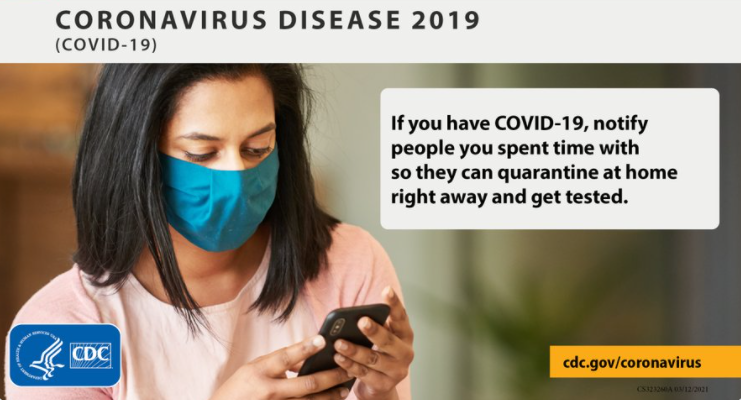
By letting your close contacts know they may have been exposed to #COVID19, you are helping to protect them and others in your community. You can call, text, or email your contacts. Learn more: bit.ly/3r2Pmd1.
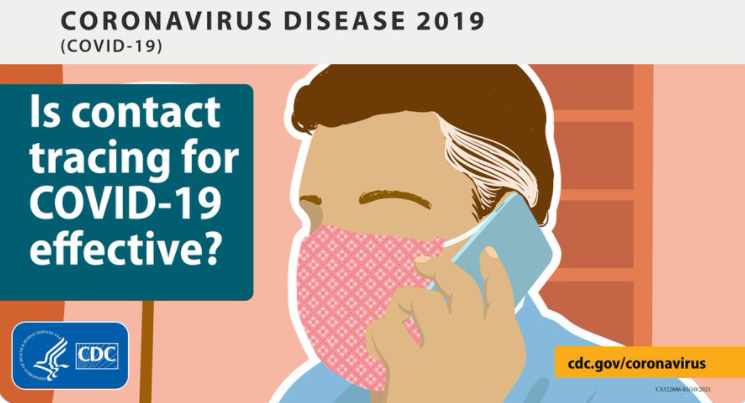
Health departments and public health professionals have used contact tracing for decades to slow or stop the spread of infectious diseases. The success of #COVID19 contact tracing depends on people’s participation. Learn more: bit.ly/2ZkyWjJ.
- If you have been exposed to COVID-19, we will call you to talk about important COVID-19 information, such as signs and symptoms of COVID-19, testing, and quarantine. Most fully vaccinated people with no COVID-like symptoms do not need to quarantine, but they should still get tested and monitor for symptoms of COVID-19 for 14 days following an exposure. Do your part to help protect your family and your community: answer the call to slow the spread. Learn more: https://www.cdc.gov/coronavirus/2019-ncov/daily-life-coping/contact-tracing.html
- If you have COVID-19, regardless of vaccination status or prior infection, someone from [insert health department name] might call you to check on your health, discuss who you’ve been in contact with, and ask you to stay at home and away from others to isolate. This information is collected for health purposes only and will not be shared with any other agencies, like law enforcement or immigration. Your name will not be revealed to your close contacts. Do your part to help protect your family and your community from COVID-19: answer the call to slow the spread. Learn more: https://www.cdc.gov/coronavirus/2019-ncov/daily-life-coping/contact-tracing.html
- If you have COVID-19, notify your close contacts—meaning people you were around in the 2 days before your symptoms started (or before your COVID-19 test, if you had no symptoms) until you started isolation. You can spread the virus to others with or without symptoms. Learn more: https://www.cdc.gov/coronavirus/2019-ncov/daily-life-coping/contact-tracing.html
- Close contacts are the people you were around in the two days before your symptoms started (or two days before your COVID-19 test, if you had no symptoms), until you started isolation. Learn more: https://www.cdc.gov/coronavirus/2019-ncov/daily-life-coping/contact-tracing.html
- By letting your close contacts know they might have been exposed to COVID-19, you are helping to protect them and others in your community. You can call, text, or email your contacts. Learn more: https://www.cdc.gov/coronavirus/2019-ncov/daily-life-coping/contact-tracing.html
- You may be considered a close contact even if you have been fully vaccinated for COVID-19, which means your health department may call or text you. Most people who are fully vaccinated and people who had COVID-19 in the previous 90 days and recovered do not need to quarantine. If people, regardless of vaccination status or prior infection, begin to experience COVID-19 symptoms or test positive for COVID-19, they should isolate from others. Learn more: https://www.cdc.gov/coronavirus/2019-ncov/daily-life-coping/contact-tracing.html
- Health departments and public health professionals have used contact tracing for decades to slow or stop the spread of infectious diseases. The success of COVID-19 contact tracing depends on people’s participation. Learn more: https://www.cdc.gov/coronavirus/2019-ncov/daily-life-coping/contact-tracing.html
- School administrators: As K–12 schools and institutions of higher education (IHEs) resume in-person learning, crucial and effective strategies to slow the spread of COVID-19 are
- Identifying people who are sick and asking those who are to isolate
- Letting people know they might have been exposed to COVID-19 and should monitor their health for signs and symptoms
- Asking people who have been exposed to COVID-19 to quarantine
- Learn about steps to take in CDC’s updated guidance for COVID-19 case investigation and contact tracing in K-12 schools and IHEs.
Example post from CDC’s Facebook account (@CDC):
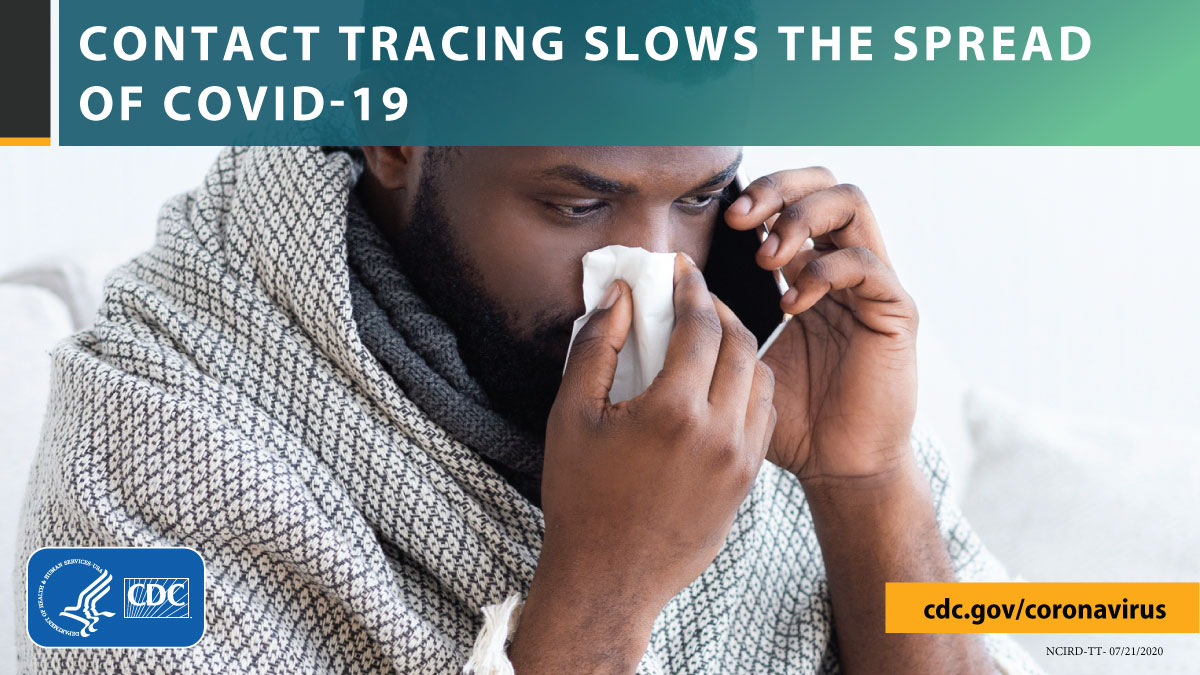
If you have COVID-19, notify your close contacts—meaning people you were around in the 2 days before your symptoms started (or before your COVID-19 test, if you had no symptoms) until you started isolation. You can spread the virus to others with or without symptoms. Learn more: bit.ly/3r2Pmd1.
- The best way to protect yourself and others is to stay home for 14 days if you think you’ve been exposed to someone who has #COVID19. Most fully vaccinated people with no COVID-like symptoms do not need to quarantine, but they should still get tested and monitor for COVID-19 symptoms. Check your local health department’s website for information about options in your area to possibly shorten this quarantine period. #CDC #PublicHealth #Coronavirus
- School administrators: As K–12 schools and institutions of higher education (IHEs) resume in-person learning, effective strategies to slow the spread of #COVID19 are:
- Identifying people who are sick and asking those who are to isolate
- Letting people know they might have been exposed to COVID-19 and should monitor their health for signs and symptoms
- Asking people who have been exposed to COVID-19 to follow public health recommendations to wear a mask, get tested, and quarantine based on their vaccination status or prior infection in the past 90 days.
Learn about steps to take in CDC’s updated guidance for COVID-19 case investigation and contact tracing in K-12 schools and IHEs.
#CDC #PublicHealth #Coronavirus
Example post from CDC’s Instagram account (@cdcgov):
For more sample social media posts, access CDC’s Social Media Toolkit.
Questions and answers
Health department staff might have questions about various topics related to case investigation and contact tracing. Visit the Contact Tracing Frequently Asked Questions and Answers webpage for additional information.
What you can expect to happen during contact tracing if you have been diagnosed with COVID-19
Additional Languages:
Chinese | Korean | Marshallese | Spanish | Vietnamese
This important resource encourages people who have COVID-19 to notify their close contacts so that they can quarantine at home and get tested.
Find other print resources that are being used to support COVID-19 recommendations.
- Contact Tracing Resources for Health Departments
- COVID-19 Contact Tracing Training and Resources
- Overview of Contact Tracing
- Interim Guidance on Developing a COVID-19 Case Investigation & Contact Tracing Plan: Overview
- Considerations for Case Investigation and Contact Tracing in K-12 Schools and Institutions of Higher Education (IHEs)
- Toolkit for Responding to COVID-19 Cases
